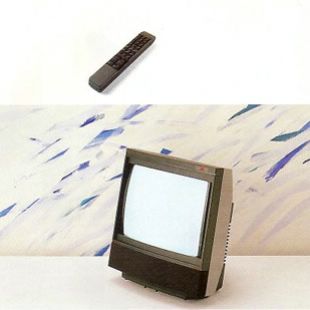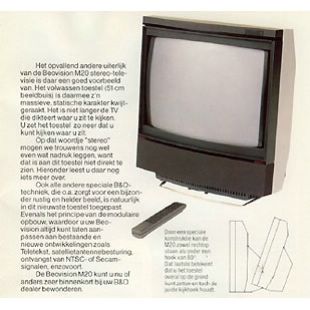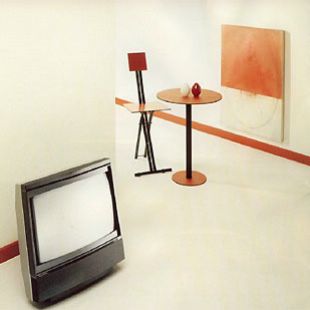BeoVision M 20
Manufactured: 1985 - 1987
Designer: David Lewis
Colours:
Beovision M20: the forerunner of Beovision MX2000
"The device appears as a well-formed cabinet from the front. From the rear, the encapsulation of the picture tube is so well done that the device may be enjoyed from all angles. The stacked-build of the device makes it possible to place it in a corner. Technically it contains many new functions, including the integration of a contrast screen that reduces disturbances from incoming light."
So wrote The Danish Design Council when presenting their 1986 ID prize for exceptional design to David Lewis and Bang & Olufsen for the Beovision MX 2000[/H]. Launched in season 1984/85 as Beovision M20, the basic conceptual elements of the Beovision MX exist virtually unchanged into the 21st century, with 2002's release of Beovision MX8000.
"Beovision MX2000 gives the impression of lightness and extended freedom of positioning. Now, all of a sudden, the TV could be positioned anywhere - even in the middle of a room"
The MX concept began as Beovision M20 in a modest grey cabinet and without a contrast screen. It sort of heralded what a monitor television by Bang & Olufsen might look like. Basically, a monitor is just a screen with a box around it. In the mid-1980s, the emphasis was on the picture and efforts to achieve a monitor look. The clean screen. Bang & Olufsen elected to make the television slim by placing the loudspeakers below the screen. This broke with the practice of several decades of placing the loudspeakers at the sides of the picture tube.
The latest MX 8000 model incorporates active loudspeakers and the sound has become even better. Previously, and with its Beovision MX 7000, Bang & Olufsen introduced yet another element that, so far, is unique to he company: a motorised base. Now the television turned to face the viewer - not vice versa.
Bang & Olufsen had a lot of difficulty explaining Bang & Olufsen's picture quality, which comprises many individual factors that have been optimised over the years. In 1985 - 86, the decision was made to combine everything that came under the term "picture quality" into a single concept - VisionClear. MX2000 was born out of the ideas for the M20 and was further equipped with VisionClear, including a contrast screen. The MX family became extremely popular and remains so (it is still being produced and sold). Designer David Lewis created a cabinet that fitted around the back of the picture tube, thereby achieving the purely psychological effect of making the picture tube appear smaller than it actually is. Beovision MX 2000 gave the impression of lightness and extended freedom of positioning. Now, all of a sudden, the TV could be positioned anywhere - even in the middle of the room.
Bang & Olufsen's first television in the the US market was a variant, Beovision MX 5000 US. But, because of sales factors and market conditions at the time, it was not a great success.
Big sound
In 1984, TV sound was produced by passive log-line loudspeakers, producing either stereo or mono sound. Whether coming from a television programme or VHS, Betamax or Video 2000 VCR, it was only experienced as coming from the TV itself. Today, multi-channel surround sound systems provide enveloping sonic experiences in the home. Back then the user listened to two 7-watt speakers in the TV itself. Today six powerful active speakers are becoming more and more popular.
In 2002, important dialogue emerges from the powerful active loudspeakers which, following the original MX design, are sill located directly below the screen.
BeoVision M 20 Product Specifications
Types:
3101 (1985 - Dec 1986)
D, TXT 3103 (1985 - Dec 1986)
F, TXT 3107 (1985 - May 1987)
GB 3104 (1985 - Oct 1985)
CTV system: B/G PAL S-tuner
Picture tube: size: 51cm
Cabinet: grey
TV programmes: 1 - 21
VCR programmes: 9, 31, 32
AV programmes: 0, 33, 34
Satellite programme: 0, 100 channels (0 - 99)
Digital tuning system: VHF 2 - 12, S1 - S19, UHF 21 - 69
Picture tube: 110° in line, black matrix, self-converging
Start time: approx. 5 sec
Speakers: stereo log line system, 2 x 8cm
Sound power output: 2 x 7 W / 8 ohms
Harmonic distortion: < 0.5% 2 W, < 3% / 7 W
Intermodulation: < 1 %
Frequency range: +/- 1.5 dB 30 - 20000 Hz (25 - 25000 Hz +/- 6 dB)
Power bandwidth: 60 - 15000 Hz
Signal-to-noise ratio: > 50 dB
Bass control: +/- 10 dB / 60 Hz
Treble control: +/- 10 dB / 10000 Hz
Power supply: 220 - 240 V
Power consumption: 70 (50 - 120) W
Stand by: < 5 W
Dimensions W x H x D: 49 x 53 x 40cm
Weight: 23 kg
Connections: A/V, audio/video IN/OUT
Headphones output
External speakers
Tape output
Amplifier output
Terminal: Video Terminal
Related Products
Created: 22nd December 2006
Modified: 3rd September 2007
Author Notes:







